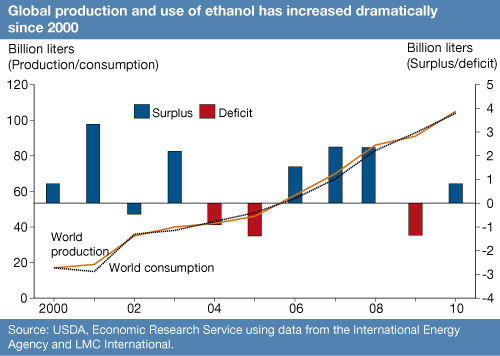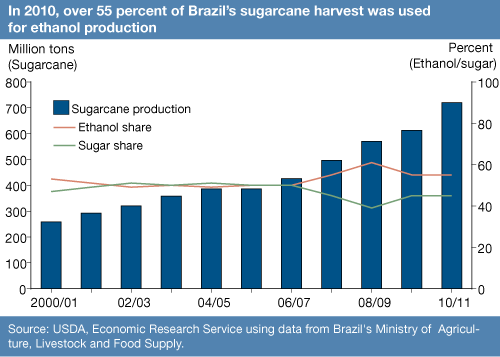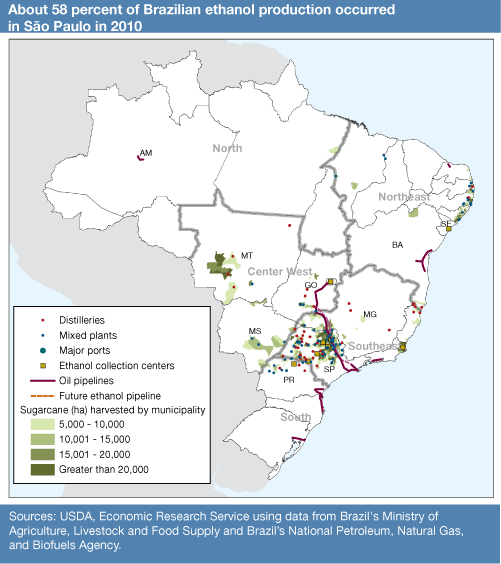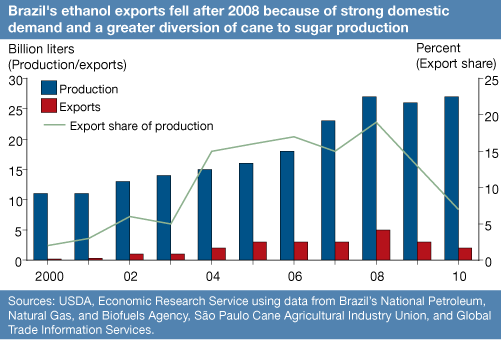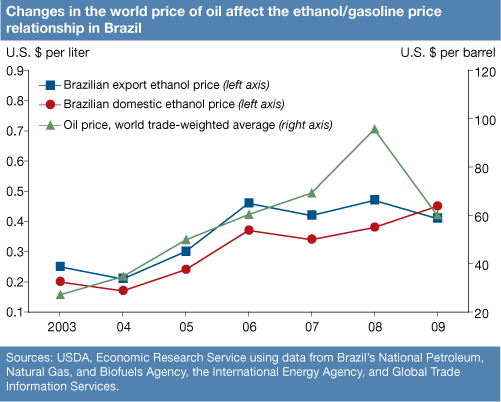Can Brazil Meet the World’s Growing Need for Ethanol?
- by Constanza Valdes
- 12/1/2011
Highlights
- Brazil is a major supplier of ethanol due to its natural advantage in sugarcane production, productivity gains in both sugarcane production and ethanol processing, and supportive government policies.
- Brazil has the potential to fill the growing world demand for ethanol based on its vast arable land area, robust productivity, and Brazilian ethanol's status as a low carbon renewable fuel.
- However, Brazil's ability to supply the world ethanol market also depends on domestic ethanol demand; relative prices of ethanol, sugar, and crude oil; the exchange value of the Brazilian real; and improvements to infrastructure.
Worldwide production and use of ethanol as an alternative to fossil fuel has increased dramatically since 2000. Ethanol demand is being driven by rising world crude oil prices, increased use of ethanol as an environmentally friendly fuel oxygenate, and government incentives in many countries to reduce dependence on fossil fuel by increasing the use of renewable energy sources. Global ethanol use will continue to rise over the next decade if countries fulfill their ethanol use targets.
Brazil is the world's second largest ethanol producer and exporter (after the United States). Several factors have combined to stimulate the development of Brazil's ethanol industry: an increased capacity to produce sugarcane as an ethanol feedstock, supportive government policies, and improved efficiency in sugarcane production and ethanol conversion processes. But Brazil will need to sustain production growth in the ethanol sector in order to meet increasing domestic demand and maintain its export share.
Brazil's Production of Sugarcane-Derived Ethanol Expanded Rapidly
Brazil is now the world's largest grower of sugarcane at 719 million tons in 2010, accounting for a third of world production. Cultivated sugarcane area has expanded rapidly from 4.3 million hectares (1 hectare = 2.47 acres) in 1990, to over 10 million hectares in 2010. Sugarcane cultivation has been central to Brazilian agricultural development since the 1950s. Sugar was Brazil's most valuable export crop in the 1950s and 1960s. In the mid-1970s, emphasis switched from sugar to ethanol production to meet domestic fuel needs, and, with the current boom in renewable fuels demand, Brazil has become a large-scale ethanol producer and exporter.
The rapid expansion in Brazil's sugarcane production is the result of a favorable climate, land availability, abundant labor, a pro-ethanol public policy, and research by public agencies to develop higher yielding cane varieties and new planting techniques to increase efficiency. While much of the expansion has been due to the conversion of former pastureland to sugarcane cultivation, with area increasing annually by 3.2 percent since 1975, productivity increases have also contributed to sugarcane growth. Continual improvements in sugarcane productivity since the 1970s have increased yields by almost 34 tons per hectare to the national average of nearly 80 tons per hectare in 2010, one of the world's highest. In São Paulo, Brazil's leading cane-producing State, yields are 20-25 percent above the national average.
In 2010, Brazilian sugarcane used for ethanol production totaled 398 million tons, or 55.4 percent of the sugarcane harvested. Domestic and global growth in ethanol demand has boosted the share of cane used for ethanol since 2006/07. The allocation of sugarcane to production of sugar versus ethanol is set by millers based on expected sugar and ethanol prices and market demand. This marks a significant change from the early years of Proálcool (Brazil's ethanol program), when the allocation of sugarcane to ethanol production was an administered policy instrument to counter oversupply of sugar and low international sugar prices.
Brazil's Ethanol Production Capacity Has Also Increased With Growing Number of Plants
Brazil's ethanol production capacity rose from 11 billion liters (1 liter = 0.26 gallon) in 2000 to 27 billion liters in 2010, accounting for 26 percent of worldwide ethanol production in that year. Brazil is now the second largest ethanol producer behind the United States. Since 2000, the number of ethanol-producing plants (distilleries and mixed sugar-ethanol processing mills) in Brazil has doubled to 430. Most are located in São Paulo (SP), which accounted for 58 percent of total Brazilian production in 2010.
Growth in ethanol production has been fastest in Brazil's Center-West region, where production has increased 15 percent yearly since 2001. This region includes the States of Goias (GO), Mato Grosso do Sul (MS), and Mato Grosso (MT), which together accounted for 16 percent of Brazil's ethanol production and where future ethanol expansion is expected to occur.
At the same time, processors are becoming more efficient in producing ethanol from sugarcane. Ethanol yields at distilleries have grown 4 percent per year since 2000 as plants have adopted more efficient processing technologies.
Brazil's position as an exporter of ethanol continues to grow in importance: the ratio of exports to production increased from an average of 4 percent in the early 2000s to 19 percent in 2008, before declining to 7 percent in 2010. Until 2008, Brazil was the world's largest supplier of ethanol, reaching a peak of 5.1 billion liters in 2008 and accounting for over 62 percent of the world ethanol export market. Brazil's ethanol exports declined in 2009 and 2010 because of strong domestic demand for ethanol and greater diversion of cane to sugar production in response to high global sugar prices and strong demand by India for sugar imports.
Government Policies Promote Brazil's Ethanol Production and Consumption
The push to promote Brazil's ethanol industry began in 1975 when the Government implemented the Proálcool program in response to soaring crude oil prices and a crisis in the international sugar market. The program encouraged replacement of imported crude oil with domestically produced ethanol, which was blended with gasoline. Under the program, the Government provided financial support for the construction of distilleries. To ensure a domestic market for ethanol, the Government stimulated demand through mandatory ethanol blending targets, subsidized credit to factories producing cars that use ethanol, and tax exemptions for consumers to buy them. Vehicles that ran only on ethanol were introduced in 1979, and by 2003, flex-fuel vehicles that can be powered by gasoline and ethanol in any proportion up to 100 percent ethanol were available. As in the U.S., support for consumption of ethanol continues through mandatory blending of ethanol with gasoline.Credit granted by public financial institutions has also been an important factor in development of the sector. Government- subsidized credit allocated to sugarcane cultivation grew from less than $200 million in 2000 to $3.1 billion in 2010, while credit allocations to the ethanol industry expanded 80 percent per year since 2000 to $1.7 billion in 2010. Historically, sugarcane producers in Brazil's Northeastern region have been given special subsidies (currently R$5 per ton) and protection because of the region's weak economy and its dependence on sugar.
Demand for Ethanol Slated To Grow in Major Consuming Countries
Demand for ethanol in major consuming countries has risen rapidly. According to the International Energy Agency, world ethanol use increased by nearly 300 percent between 2000 and 2010, with consumption reaching over 104 billion liters. Global ethanol trade nearly doubled during the same period, but at 5.9 billion liters in 2010, world trade is still a small share of total use. World demand for ethanol is expected to continue to increase in response to anticipated economic growth, rising oil prices, and the mandates in many countries to replace fossil fuel use with renewable energy sources. Brazil is in a good position to satisfy demand: sugarcane-based ethanol is one of the most efficient sources of biofuel per hectare, with a yield in liters of ethanol per hectare that is almost double that of corn-based ethanol, according to USDA.
The U.S. and the European Union (EU) are two of the major consuming markets for Brazilian ethanol. The U.S. Energy Independence and Security Act (EISA) of 2007 requires transportation fuel producers to use at least 136 billion liters of biofuels by 2022. The Renewable Fuel Standard (RFS) provision established under EISA mandates minimum use of 57 billion liters of corn-based ethanol by 2015, up from about 49 billion liters in 2010. The RFS also requires the use of at least 80 billion liters of cellulosic and advanced biofuels (which includes ethanol from sugarcane and biodiesel) by 2022. The 54-cent per-gallon surcharge on imported ethanol is scheduled to expire at the end of 2011. If this happens, it may stimulate U.S. imports of Brazilian ethanol.
The EU's Renewable Energy Directive sets a mandatory minimum share of renewable energy in total fuel consumption in the transport sector of 10 percent per member state by 2020. While biodiesel is the principal biofuel used in Europe, the European Commission estimates that its ethanol consumption could rise from less than 5 billion liters in 2010 to about 10 billion liters by 2020. Several other importing countries, including Japan, have energy mandates that encourage the use of agriculture-based ethanol in their transportation sectors.
Brazil's Ability To Expand Ethanol Exports Uncertain
Global ethanol production, concentrated in only a few producing countries, may not keep pace with rapidly growing demand. Concerns about food and fuel tradeoffs may limit some countries' ability to increase ethanol production, particularly production of ethanol from grains. Based on USDA long-term projections, Brazil's ethanol production is expected to rise 45 percent during the coming decade to 43.8 billion liters by 2020. However, Brazil's ability to provide the bulk of the world's import needs will depend on its domestic ethanol demand, world sugar and oil prices, Brazil's currency exchange rate, and the capacity of its infrastructure to move ethanol to ports.
Growing domestic demand is certain to put pressure on Brazil's export supply. Brazil is the world's second largest ethanol consumer, behind the United States, and accounts for over 30 percent of global ethanol consumption. Brazil's domestic demand is projected to grow as sales of flex-fuel cars rise with increased income.
The world price of sugar is an important determinant of Brazilian ethanol supply. When the sugar price is high, more sugarcane is used for sugar; lower sugar prices favor conversion of sugarcane to ethanol. In 2009-10, drought in Brazil led to a smaller sugarcane harvest, declining stocks, and higher sugar import demand in major consuming countries such as India, China, and Pakistan. With higher international sugar prices, a larger share of the Brazilian sugarcane crop was allocated to sugar production. In late 2010, when the world sugar price fell to under 14 cents per pound from a 29-year high of 30 cents per pound earlier that year, the share of sugarcane used for ethanol rebounded.
Although the ethanol blend requirement tends to insulate Brazil's domestic ethanol prices from fluctuations in world oil prices, changes in the world price of oil affect the ethanol/gasoline price relationship in Brazil. When oil prices fall, ethanol demand weakens. Conversely, higher world oil prices encourage increased use of ethanol in Brazil's rapidly expanding fleet of flex-fuel vehicles.
Both real (adjusted for inflation) and nominal exchange rates have enormous effects on Brazil's international competitiveness, export volumes, farm earnings, and processing margins for distilleries and sugar-ethanol processing mills. Brazil's currency, the real, appreciated in 2009, making Brazil's ethanol exports more expensive and reducing the competitiveness of Brazil's ethanol in the world market. Brazil's ethanol exports slipped to 3.3 billion liters in 2009 and to 1.9 billion liters in 2010.
Infrastructure Constraints Present Further Obstacles
Brazil faces considerable infrastructure and transportation constraints along its ethanol supply chain. The bulk of ethanol is transported from processing plants to collection centers and then to ports by truck. Adequate and modern road infrastructure is thus critical to maintain competitiveness in the industry. Poor roads impose even higher costs on farmers located in the Center-West frontier, where new distilleries are being established. The average distance from the Center-West region to export ports is over 600 miles.
Large investments in maintenance and expansion of road infrastructure are needed to keep up with the expected growth in demand and to lower delivery times and costs. Brazil's state-owned oil company, PETROBRAS, plans to start building two ethanol pipelines by 2012--a 715-mile-long pipeline from Goiás to the port of São Sebastião on the southeast coast and a 325-mile-long pipeline from Minas Gerais to the port in Rio de Janeiro. PETROBRAS estimates that the new pipelines, to be completed by 2016, will accommodate about 22 billion liters (doubling current transportation capacity) at about one-third the current cost of shipping ethanol by truck. The Government has allocated $4.6 billion for improvements in port infrastructure by 2016.
Can Brazil's Ethanol Industry Meet Global Demand?
Several factors favor the ability of Brazilian ethanol producers to increase production of ethanol from sugarcane and fill future global ethanol needs. Brazil has large areas of arable savannas that could be brought into production of sugarcane without risk of deforestation. Brazil's Ministry of Agriculture, Livestock and Food Supply estimates the scope for cropland expansion in Brazil at 119 million hectares, with 69 million hectares in savannas and 50 million hectares from pastureland conversion. According to USDA long-term projections, an additional 12 million hectares of Brazilian cropland will be brought into crop production over the next decade.
Technological advances to boost sugarcane yields per hectare and efficiency gains in producing ethanol from sugarcane seem assured given the new technologies being generated by the Brazilian Corporation for Agricultural Research. Brazil's current yields of 90-100 liters of ethanol per ton of sugarcane are projected to increase by an additional 80 percent over the next decade based on new technologies, including the use of crushed sugarcane stalks, or bagasse, for further processing of the sucrose content for ethanol. The Brazilian Economic Development Bank has allocated $22 billion for investments in 2011-14 to double the sector's production capacity over the next decade. Plans for new investments in the construction of new distilleries will provide an additional 18 billion liters of ethanol production capacity by 2020, according to UNICA (the Brazilian sugarcane industry association).
A number of other conditions will be necessary for Brazil to fulfill a large part of future global ethanol demand. Sugar and crude oil prices will need to remain at levels that will encourage increases in ethanol production beyond gains that can be realized through technological advances. Planned construction of pipelines and mill/port ethanol storage capacity investments must occur. The policy environment in which Brazil's ethanol industry operates will also have a major influence on future production and investment trends. The Brazilian Government announced in April 2011 that Brazil's National Petroleum Agency will regulate the chain of production of ethanol, including exports, to treat ethanol as a 'strategic fuel' and no longer as an agricultural commodity, in an effort to provide a stable and reliable supply of ethanol. An easing of the government-mandated fuel alcohol content in gasoline would result in increased Brazilian sugar production and exports.
This article is drawn from:
- Valdes, C. (2011). Brazil's Ethanol Industry: Looking Forward. U.S. Department of Agriculture, Economic Research Service. BIO-02.
You may also like:
- Brazil. (n.d.). U.S. Department of Agriculture, Economic Research Service.
We’d welcome your feedback!
Would you be willing to answer a few quick questions about your experience?


